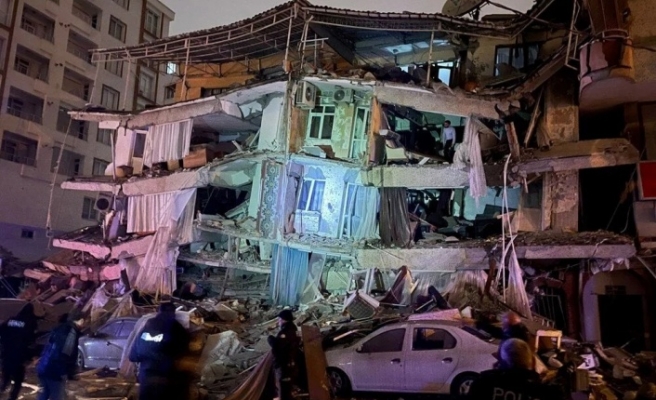Established in 2000 after the 1999 Marmara earthquake, TCIP provides financial security to insured homeowners against earthquake and earthquake-induced fire, explosion, landslide and tsunami risks with its Compulsory Earthquake Insurance.
Compulsory earthquake insurance rate was also revealed in 10 provinces affected by the earthquake in Kahramanmaraş. According to TCIP data, this rate is on average 49%.
While the highest rate in the policy is in Gaziantep, 113 thousand 11 of 210 thousand houses in Kahramanmaraş, the epicenter of the earthquake, have compulsory insurance.
The maximum guarantee amount given by TCIP was determined as 640 thousand liras for all building types. According to the data, there are 20 million 32 thousand residences throughout Turkey. The number of those who have Compulsory Earthquake Insurance is 10 million 949 thousand 642. The rate is 54.70 percent.
MANDATORY EARTHQUAKE INSURANCE RATE IN 10 CITIES 49 PERCENT
According to the news in Dünya Newspaper, the Compulsory Earthquake Insurance rate in the 10 provinces at the center of the earthquake is at an average level of 49 percent. 113 thousand of 210 thousand houses in Kahramanmaraş have Compulsory Earthquake Insurance policy.
THE HIGHEST RATE IS IN GAZIANTEP
The figures in other provinces are as follows; 40.1 percent of 315 thousand houses in Hatay, 42.4 percent of 101 thousand houses in Osmaniye, 64.5 percent of 339 thousand houses in Gaziantep, 59.7 percent of 25 thousand houses in Kilis. 52.9 percent of 198 thousand residences in Şanlıurfa, 45.9 percent of 479 thousand residences in Adana, 52.1 percent of 188 thousand residences in Malatya, 44 percent of 89 thousand residences in Adıyaman, 9, 33 percent of 231,000 residences in Diyarbakır have Compulsory Earthquake Insurance policy.
WHAT DOES THE MANDATORY EARTHQUAKE INSURANCE INSURANCE?
Compulsory Earthquake Insurance, in general terms, is an insurance system developed to cover the material damages caused by the earthquake for the residences within the boundaries of the municipality. The buildings defined below are insured with Compulsory Earthquake Insurance:
Buildings built as residences on immovables registered in the title deed and subject to private ownership
Independent sections within the scope of Condominium Law No. 634
Independent sections located in these buildings and used for commercial, office and similar purposes
Houses built by the government due to natural disasters or with loans given
Compulsory Earthquake Insurance also complies with the above conditions; buildings with condominium
The genus correction has not yet been made in the land registry and the qualification is “land etc.” in the land registry. buildings that appear as
It is valid for cooperative houses where the title deed allocation has not been made yet.
WHAT DOES DASK MEET?
With the Compulsory Earthquake Insurance, TCIP covers the material damages caused directly by the earthquake and the fire, explosion, tsunami and landslide that occur as a result of the earthquake, within the limits specified in the policy.
Foundations, main walls, common walls separating independent sections, garden walls, retaining walls, atvans and floors, stairs, elevators, landings, corridors, roofs, chimneys, complementary parts of the building similar to the above are covered together or separately.
HOW IS THE INSURANCE COST CALCULATED?
TCIP offers guarantees up to a maximum amount determined in parallel with the increase in building costs every year.
In the determination of the Maximum Collateral Amount, the reconstruction cost of the buildings (excluding the land value), which constitutes a large part of the existing building stock, is taken into account.
The coverage amount (insurance cost) of those who take out insurance is determined according to the size and construction style of their residences, not to exceed this maximum coverage amount.
If the value of the house exceeds the amount of coverage given by TCIP, the insured may optionally take out housing insurance from insurance companies for the excess.
The land price of the house is not included in the insurance cost.
WHAT DOES THE MANDATORY EARTHQUAKE INSURANCE INSURANCE?
Compulsory Earthquake Insurance, in general terms, is an insurance system developed to cover the material damages caused by the earthquake for the residences within the boundaries of the municipality. The buildings defined below are insured with Compulsory Earthquake Insurance:
Buildings built as residences on immovables registered in the title deed and subject to private ownership
Independent sections within the scope of Condominium Law No. 634
Independent sections located in these buildings and used for commercial, office and similar purposes
Houses built by the government due to natural disasters or with loans given
Compulsory Earthquake Insurance also complies with the above conditions; buildings with condominium
The genus correction has not yet been made in the land registry and the qualification is “land etc.” in the land registry. buildings that appear as
It is valid for cooperative houses where the title deed allocation has not been made yet.
WHAT DOES DASK MEET?
With the Compulsory Earthquake Insurance, TCIP covers the material damages caused directly by the earthquake and the fire, explosion, tsunami and landslide that occur as a result of the earthquake, within the limits specified in the policy.
Foundations, main walls, common walls separating independent sections, garden walls, retaining walls, atvans and floors, stairs, elevators, landings, corridors, roofs, chimneys, complementary parts of the building similar to the above are covered together or separately.
HOW IS THE INSURANCE COST CALCULATED?
TCIP offers guarantees up to a maximum amount determined in parallel with the increase in building costs every year.
In the determination of the Maximum Collateral Amount, the reconstruction cost of the buildings (excluding the land value), which constitutes a large part of the existing building stock, is taken into account.
The coverage amount (insurance cost) of those who take out insurance is determined according to the size and construction style of their residences, not to exceed this maximum coverage amount.
If the value of the house exceeds the amount of coverage given by TCIP, the insured may optionally take out housing insurance from insurance companies for the excess.
The land price of the house is not included in the insurance cost.





